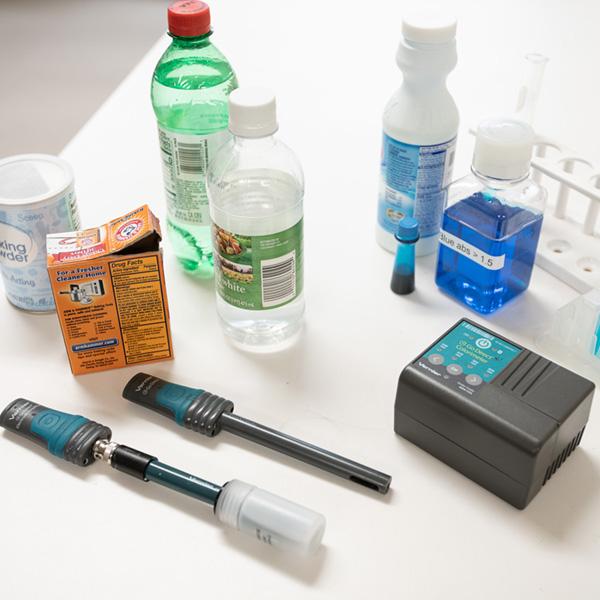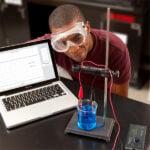
Sharing ideas and inspiration for engagement, inclusion, and excellence in STEM

It can be challenging for students to wrap their minds around key chemistry concepts, such as pH, Beer’s law, and gas conversions. You can help demystify these abstract scientific ideas with hands-on learning that incorporates common household items.
There’s a lot of chemistry that can be taught using things you can get from the grocery store or the hardware store. And I speak from experience; during my 30-plus years of teaching chemistry, I used a range of everyday items, such as bleach and food coloring, in my classroom labs.
Want some ideas to incorporate into your own teaching? Here are five common household items you can use to explore chemistry concepts with your students.
1. Vinegar
If you require an acid for a chemical reaction, you often need to look no further than vinegar. This multipurpose liquid is also a great tool for learning more about key chemistry concepts. For example, titrating vinegar is a simple way to teach your students how to measure pH and determine the acid concentration of a substance.
If you want to use an experiment to take a deeper dive into these concepts, “I’m Drinking Acid?!” is an excellent option. In this experiment, students use a Go Direct® pH Sensor to measure the pH of common beverages, such as soda, fruit juice, and sports drinks; learn the technique of titration; and determine the concentration of acid in a common beverage.
2. Baking Soda and Baking Powder
These humble pantry staples are actually powerhouses for hands-on chemistry learning. One option is to use baking soda and baking powder, as well as the Go Direct Gas Pressure Sensor or Go Direct CO2 Gas Sensor, to explore chemical properties. Because baking powder can contain a dry acid (unlike baking soda), it starts to react when it gets wet—but baking soda requires the addition of an acid or the application of heat to produce a reaction.
Another option is to use baking soda and baking powder, along with sugar, salt, and aspirin, to teach your students about physical properties. The idea is that students have to determine how the characteristics of five white, powdery substances are similar and different. Great tools to support this learning include the Go Direct Conductivity Probe, Go Direct pH Sensor, and Go Direct Melt Station.
3. Iron-Fortified Cereal
Breakfast might not be the first thing that comes to mind when you think about chemistry. But iron-fortified cereal, such as Total, can provide an interesting way to explore Beer’s law and teach your students how to measure the concentration of different substances (in this case, iron). Plus, iron-fortified flakes will cling to a magnet dropped into a box of this cereal—a fun visual aid for students.
“Quantifying Iron in Cereal” gives learners an opportunity to explore Beer’s law, that is, the concentration of a solution. This experiment involves the use of the Go Direct SpectroVis® Plus Spectrophotometer or Go Direct Visible Spectrophotometer, the Go Direct Temperature Probe, and our free Vernier Spectral Analysis® app. The objectives of the experiment include
- Create the iron(II) ion from the metallic iron in the cereal.
- React the iron(II) ion with 1,10-phenanthroline reagent to result in a color.
- Construct a graph of absorbance vs. concentration for known solutions of iron(II) ion-phenanthroline complex.
- Measure the absorbance of iron(II) extracted from a serving of cereal.
- Calculate the concentration and mass of iron contained in one serving of cereal.
4. Alka-Seltzer®
Plop, plop. Fizz, fizz. Alka-Seltzer helps relieve indigestion—but that’s just the start. These effervescent tablets can also provide great opportunities for hands-on chemistry learning, in no small part because they generate carbon dioxide. For instance, students can use Alka-Seltzer and the Go Direct CO2 Gas Sensor to explore gas laws and conversions. Additionally, when paired with the Go Direct Gas Pressure Sensor, Alka-Seltzer is an excellent tool for studying Avogadro’s law.
5. Invisible Ink Pens
Although you might have to go to a toy store to get them, invisible ink pens are a fun item to add to your teaching toolbox. As it relates to chemistry, these writing utensils can help illuminate atomic theory and fluorescence for your students—when used in concert with the Go Direct SpectroVis Plus Spectrophotometer (in fluorescence mode).
The common household items I’ve mentioned are wonderful tools to support hands-on chemistry learning. However, this blog post only scratches the surface!
If you’re looking to take a deeper dive, check out Reaction Transformation: Teaching Kinetics with Food Coloring and Bleach. In this webinar, I show you how to use two common household items to explore the kinetics of a chemical reaction. I also provide strategies for teaching this important scientific concept, including using calculated columns to determine the order of reaction and the rate expression.
We’d love to hear how you have used common household items to support hands-on chemistry learning, and we’re always happy to brainstorm ideas! Feel free to contact us at chemistry@vernier.com or 888-837-6437.
Share this Article

Sign up for our newsletter
Stay in the loop! Beyond Measure delivers monthly updates on the latest news, ideas, and STEM resources from Vernier.






